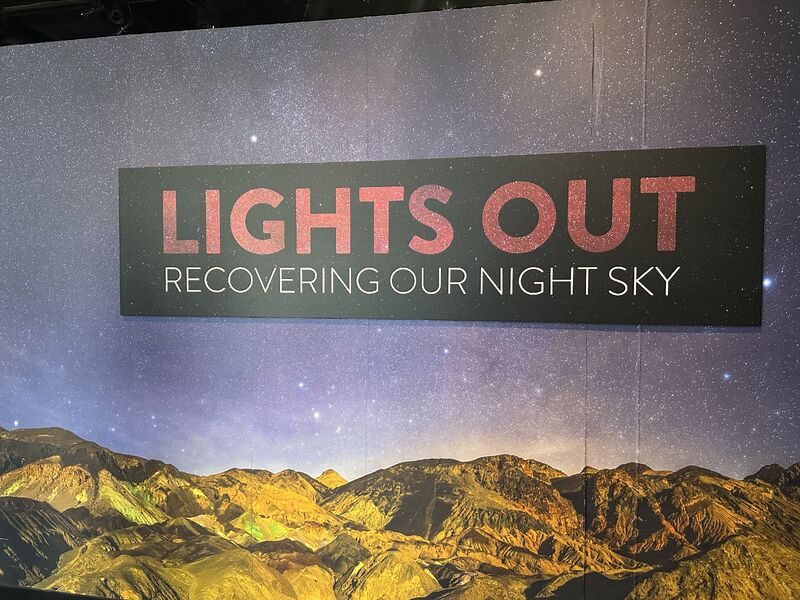By Professor Tiffany Banks On Tuesday, September 30th , students from my COMM 108: Foundations…
by Professor Matthew Decker, English
I’ve been a college English professor—a role undeniably designated to the realm of true adulting—for nearly 8 years, but I still vividly recall some of my elementary and middle school field trips. I remember sheepishly ducking out of the way as cooler classmates fought each other for seats at the back of the bus. And I can picture the imposing façade of my first museum as well as feel the magic energy of the National Aquarium in Baltimore. That second space is forever emblazoned in my memory, for it was also the first time I was brought to such nerdy excitement that I passed out in the middle of an exhibit space. It turns out, medically, I had the flu, but I like to think it was hardcore nerding out. More than a decade later, as a recent college grad working at a Dutch campsite in Italy, I took a day trip to Florence and found myself unabashedly crying in front of Botticelli’s The Birth of Venus hanging in the Uffizi Gallery. I had never seen anything so beautiful, and, despite all my efforts as a self-conscious young man, I couldn’t stop the tears.
I know so very well that I feel “all the things” when I wander the hallways of museums.
So, when I began the Smithsonian Faculty Fellowship journey at Montgomery College this past spring, it was the meaningful, emotionally-impactful experiences like my own that initially inspired my hopes for my students during the museum visit. I learned, of course, that all museum visitor experiences are distinct, and, often, a museum can be quite daunting when entered without context or a mission. If I wanted my two English 102 classes to enjoy their time at the National Portrait Gallery, the space I selected for our museum-based assignment, I needed to ensure their competence and satisfaction. These are key components of a museum visit emphasized in John Falk’s text Identity and the Museum Visitor Experience, and, like every strong student, I take advantage of my resources and I share them with others.
Ultimately, Falk’s recommendations inspired a series of in-class preliminary assignments designed to prepare students for the field trip. We photographed personal “identity artifacts” and uploaded them to the Smithsonian Learning Lab as a way to curate our own gallery space; we studied the rhetorical situations of numerous online exhibits and analyzed their audience impact and special strategies; we close-read Kehinde Wiley’s LL Cool J and Amy Sherald’s Grand Dame Queenie with the help of a phenomenal observation questionnaire from the NPG; we discussed field trip dates, times, travel, assigned exhibits, Remind communication, and more; we agreed that inviting family and friends was essential—we looked at the museum visit from every possible angle to guarantee competence and satisfaction.
When September 27 and 29 finally arrived, we were ready! On the first day, I traveled from the Takoma Park metro station with Felix and Suliman, two past 101A students. The three of us enjoyed a photoshoot in front of the National Portrait Gallery just before it opened at 11 AM. In the central courtyard of the building, we ran into Oscar and his parents as well as another classmate, Nana, who traveled on his own. For the first hour, we established a base for heavy bags and other items, huddled to discuss best strategies for visiting the four assigned exhibits—The Struggle for Justice, In Mid-Sentence, 20th Century Americans, and Contemporary Americans—and reminded one another to work hard but have fun while searching for the portrait that would become the heart of this semester’s second writing assignment, an open-ended Argument Synthesis essay that allows them the freedom to argue a unique point about an artwork with the support of research. When students arrived later in the day, we would communicate using Remind, find a meeting space to review goals, and then continue our respective journeys. Since our visit was scheduled for earlier in the semester, too, I didn’t want to force interactions, but I shared with all students that I would wander the assigned exhibits to chat with them organically or they could simply text me if they wanted my help examining a portrait of interest.
Some of my favorite moments of both days in the National Portrait Gallery with my students centered on discovering them in action. Marylin, Kelly, Oscar, and Nana were found wandering 20th Century Americans together, and I forced the following photo: 
Twin sisters Helena and Valquiria were captured dutifully taking notes in another room:
A very kind Sergius agreed to pose in the center of an incredible tiny museum artwork:
Later, Alia and I celebrated her selection of Charlayne Hunter-Gault’s portrait for her essay assignment:
At the beginning of the planning process for this field trip, I’ll admit I was a bit nervous, but I always had my idealized vision of what this experience would be for the students. I expected they would wander the hallways with me, and I would catch that glimmer of excitement that sparks when they find an artwork that speaks to them. That we would share our observations of a portrait in a thoughtful sideline chat. That students would wax poetic about how meaningful this visit was for them. And, this did happen for a few students. No one fainted due to overenthusiasm, though, and I’m aware that’s a good thing…I guess. For other students, a personal journey through the museum was all they needed, so we simply met at the beginning and then went our separate ways. Others sat with me to discuss topics outside the museum experience, like anxiety and struggles to concentrate in class. I was the photographer for students and their families and, I assume, Instagram. I was a fellow brainstormer engaged in scrolling all the photos students took of the artworks and labels that most inspired them.
Today, the museum visit is in the past, but these memories—both big and small—have lingered with me. I hope the same for my students, and, now, I simply look forward to devouring what they write about their portraits, what they found to be meaningful about the artwork that maybe didn’t bring them to tears but did cause them to stop, think, and wonder.





This Post Has 0 Comments